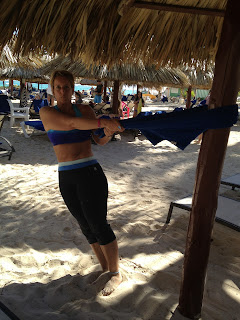Endurance. How do you build it? And is endurance just about how long your body can last, or does it have a component of mental toughness? How do some people seem to be able to run for hours and hours easily, while other struggle to just run a mile?
First, let's get the genetic component out of the way. Clearly, there are people who are just genetically compatible with long endurance related activities, in part due to their muscle fiber make-up. Some folks have a larger proportion of slow twitch muscle fibers, which makes endurance work easier for them. And some have more fast twitch fibers, making them better suited to sprint work and explosive sports which require quick starts and stops and not continuous movement.
But, let's say you do want to build whatever endurance you can, with what you've got. This can be done, with diligence and hard work. And some mental toughness is required, since the road isn't necessarily and easy one. Let's say you want to be able to run, and you've never been able to--how do you start?
The first rule is not to add too much to fast. Ok, let me backtrack just a bit--first make sure you have good supportive shoes that are appropriate for the activity at hand. If you are unsure, place like InStep can help you with the proper footwear. Then, you are going to pick a one mile route. Pick places where you can try a light jog, and places where you can walk; In my neighborhood, we have a winding road that attaches a court system, so you can walk the main road and run the court, or vice versa. Or you could pick a number of houses or mailboxes--I'll run to the 3rd mailbox, and walk 4 mailboxes/houses, and then run again. Then go home and stretch.
The second rule (it's my own rule based on my experience, I don't think it's written anywhere but here)--you need adequate rest in order to move forward and to avoid injury. So if you get overly ambitious, and don't allow your body to adapt, you are going to be sorry. I set to much volume and not enough rest, and ended up with a sore foot and sharp pain in one knee that set my training back a week and a half. So, maybe you do this pattern above, 3-4 times the first week, and then give yourself a new goal.
The next week, you see if you can jog a bit more--set the goal to jog more houses, or walk only 1/2 the court, and run the rest, plus the parts between courts...you decide. The goal here is to get that mile to all running, so you are trying to do just that little bit more.
The third week, you try to jog the whole mile, knowing you may need to stop a couple of times along the way to catch your breath, but pick a pace that keeps you pretty steady, so you don't have to, even if that looks like my old golden retriever--old man running I call it--you look like you're running, but it might be just over a walking pace. That's ok, you're doing a great job, and your body is doing it's best to keep up and make the changes you are asking for. You might be a little bit uncomfortable.
Sometime around week 4, you should be jogging this entire mile route. Yea! You rock! Now, your initial goal of running a mile is complete, and if you want to, you can add a bit more to your route. Not a lot, mind you--maybe you go for extra time, like 5 more minutes, or maybe you think about adding 1/4 mile this next week.
If you go about this systematically, and you do the work consistently, you will see the results. Don't compare yourself to anyone else, this is for you. Work on your dreams one at a time, with a systematic approach, and you will accomplish them.
Have a great week!
--
Melissa Abramovich
ACE CPT, NASM CGT, CPT,
AAHFRP Medical Exercise Specialist
"Excuses are the nails that build houses of failure"












